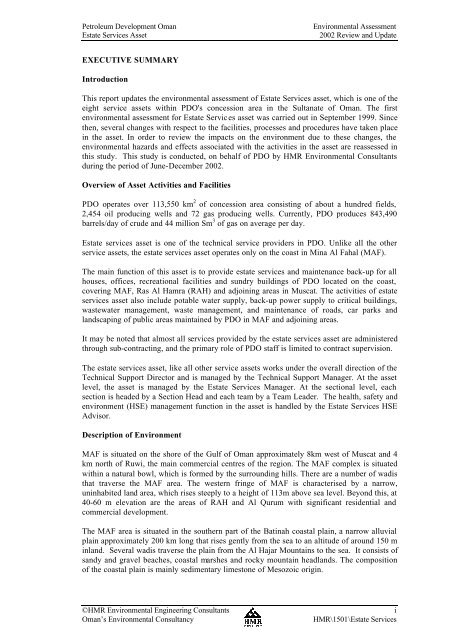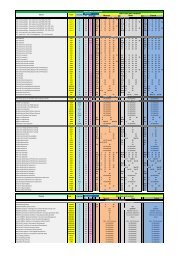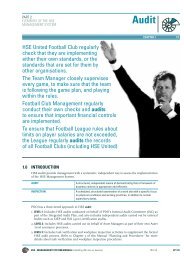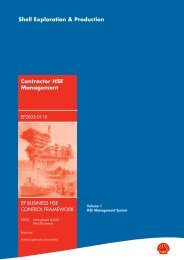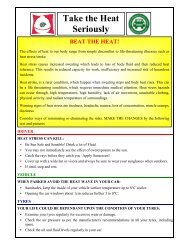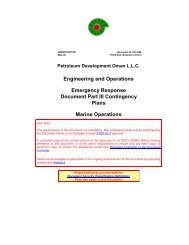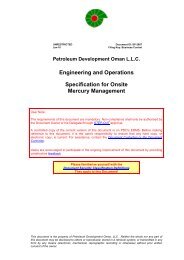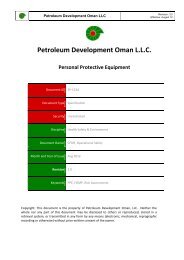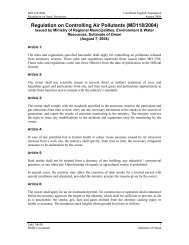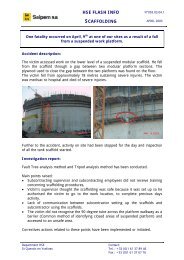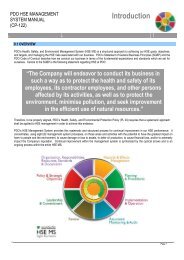Estate Service Asset - PDO
Estate Service Asset - PDO
Estate Service Asset - PDO
Create successful ePaper yourself
Turn your PDF publications into a flip-book with our unique Google optimized e-Paper software.
Petroleum Development Oman<br />
<strong>Estate</strong> <strong>Service</strong>s <strong>Asset</strong><br />
Environmental Assessment<br />
2002 Review and Update<br />
EXECUTIVE SUMMARY<br />
Introduction<br />
This report updates the environmental assessment of <strong>Estate</strong> <strong>Service</strong>s asset, which is one of the<br />
eight service assets within <strong>PDO</strong>'s concession area in the Sultanate of Oman. The first<br />
environmental assessment for <strong>Estate</strong> <strong>Service</strong>s asset was carried out in September 1999. Since<br />
then, several changes with respect to the facilities, processes and procedures have taken place<br />
in the asset. In order to review the impacts on the environment due to these changes, the<br />
environmental hazards and effects associated with the activities in the asset are reassessed in<br />
this study. This study is conducted, on behalf of <strong>PDO</strong> by HMR Environmental Consultants<br />
during the period of June-December 2002.<br />
Overview of <strong>Asset</strong> Activities and Facilities<br />
<strong>PDO</strong> operates over 113,550 km 2 of concession area consisting of about a hundred fields,<br />
2,454 oil producing wells and 72 gas producing wells. Currently, <strong>PDO</strong> produces 843,490<br />
barrels/day of crude and 44 million Sm 3 of gas on average per day.<br />
<strong>Estate</strong> services asset is one of the technical service providers in <strong>PDO</strong>. Unlike all the other<br />
service assets, the estate services asset operates only on the coast in Mina Al Fahal (MAF).<br />
The main function of this asset is to provide estate services and maintenance back-up for all<br />
houses, offices, recreational facilities and sundry buildings of <strong>PDO</strong> located on the coast,<br />
covering MAF, Ras Al Hamra (RAH) and adjoining areas in Muscat. The activities of estate<br />
services asset also include potable water supply, back-up power supply to critical buildings,<br />
wastewater management, waste management, and maintenance of roads, car parks and<br />
landscaping of public areas maintained by <strong>PDO</strong> in MAF and adjoining areas.<br />
It may be noted that almost all services provided by the estate services asset are administered<br />
through sub-contracting, and the primary role of <strong>PDO</strong> staff is limited to contract supervision.<br />
The estate services asset, like all other service assets works under the overall direction of the<br />
Technical Support Director and is managed by the Technical Support Manager. At the asset<br />
level, the asset is managed by the <strong>Estate</strong> <strong>Service</strong>s Manager. At the sectional level, each<br />
section is headed by a Section Head and each team by a Team Leader. The health, safety and<br />
environment (HSE) management function in the asset is handled by the <strong>Estate</strong> <strong>Service</strong>s HSE<br />
Advisor.<br />
Description of Environment<br />
MAF is situated on the shore of the Gulf of Oman approximately 8km west of Muscat and 4<br />
km north of Ruwi, the main commercial centres of the region. The MAF complex is situated<br />
within a natural bowl, which is formed by the surrounding hills. There are a number of wadis<br />
that traverse the MAF area. The western fringe of MAF is characterised by a narrow,<br />
uninhabited land area, which rises steeply to a height of 113m above sea level. Beyond this, at<br />
40-60 m elevation are the areas of RAH and Al Qurum with significant residential and<br />
commercial development.<br />
The MAF area is situated in the southern part of the Batinah coastal plain, a narrow alluvial<br />
plain approximately 200 km long that rises gently from the sea to an altitude of around 150 m<br />
inland. Several wadis traverse the plain from the Al Hajar Mountains to the sea. It consists of<br />
sandy and gravel beaches, coastal marshes and rocky mountain headlands. The composition<br />
of the coastal plain is mainly sedimentary limestone of Mesozoic origin.<br />
©HMR Environmental Engineering Consultants<br />
Oman’s Environmental Consultancy<br />
i<br />
HMR\1501\<strong>Estate</strong> <strong>Service</strong>s


